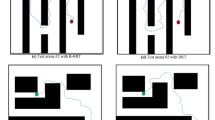Abstract
In order to solve the problems of the Informed-RRT* algorithm in path planning, such as blindness, uneven sampling, and unsmooth paths, an improved Informed-RRT* algorithm based on adaptive growth strategy and elliptical region variable weight sampling strategy with trajectory optimization is proposed in this paper. At first, an adaptive growth strategy is developed to address the blindness issue by considering the effect of the target point and any obstacles when selecting new nodes. Second, to address the issue of unequal sampling within the ellipse, an elliptical region variable weight sampling strategy is presented. This strategy increases the number of nodes in the vicinity of the target point. Finally, the minimum snap method is used to determine the best trajectory for the non-smooth path. The dynamic corridor constraint is used to reduce the difference between the trajectory and the path as small as possible while avoiding collisions with obstacles. The simulation experiments show that the improved algorithm cuts by 27.83% the time it takes to find the initial path, and by 16.91% the time it takes to find the best path. The optimized and smoothed path can be turned into acceleration at the right time to make motion control easier.










Similar content being viewed by others
References
Ryu, H., & Park, Y. (2019). Improved informed rrt* using gridmap skeletonization for mobile robot path planning. International Journal of Precision Engineering and Manufacturing, 20(11), 2033–2039.
Tan, J., Pan, B., Wang, Y., & Cui, H. (2020). Robot path planning based on improved rrt* fn algorithm. Control Decision, 36(08), 1834–40.
Tang, Y. X., Zhu, Z. X., Zhang, H. W., Luo, J. J., & Yuan, J. P. (2022). A tutorial and review on robot motion planning. Acta Aeronautica et Astronautica Sinica, 66, 1–34.
Wang, L. C., Yong, L. S., & Ang, M. H. (2002). Hybrid of global path planning and local navigation implemented on a mobile robot in indoor environment. In Proceedings of the IEEE international symposium on intelligent control (pp. 821–826). IEEE.
Wang, Z., Hu, X., Li, X., & Du, Z. (2022). Overview of global path planning algorithms for mobile robots. Computer Science, 48(10), 19–29.
Shaikh, E. A., & Dhale, A. (2013). Agv path planning and obstacle avoidance using Dijkstra’s algorithm. International Journal of Application or Innovation in Engineering & Management (IJAIEM), 2(6), 77–83.
Tang, G., Tang, C., Claramunt, C., Hu, X., & Zhou, P. (2021). Geometric a-star algorithm: An improved a-star algorithm for agv path planning in a port environment. IEEE Access, 9, 59196–59210.
Tian, L., & Collins, C. (2004). An effective robot trajectory planning method using a genetic algorithm. Mechatronics, 14(5), 455–470.
Miao, C., Chen, G., Yan, C., & Wu, Y. (2021). Path planning optimization of indoor mobile robot based on adaptive ant colony algorithm. Computers & Industrial Engineering, 156, 107230.
Bordalba, R., Ros, L., & Porta, J. M. (2018). Randomized kinodynamic planning for constrained systems. In 2018 IEEE international conference on robotics and automation (ICRA) (pp. 7079–7086). IEEE.
Bordalba, R., Ros, L., & Porta, J. M. (2020). A randomized kinodynamic planner for closed-chain robotic systems. IEEE Transactions on Robotics, 37(1), 99–115.
Salzman, O., & Halperin, D. (2016). Asymptotically near-optimal rrt for fast, high-quality motion planning. IEEE Transactions on Robotics, 32(3), 473–483.
Wan, S., Li, X., Su, W., & Hong, J. (2022). Milling chatter mitigation with projection-based robust adaptive controller and active magnetic bearing. International Journal of Precision Engineering and Manufacturing, 66, 1–11.
Jeon, M., Jeong, S.-K., Kang, J.-G., Yeo, W.-J., Kim, Y.-J., Choi, H.-J., & Lee, W. (2022). Prediction model for edge effects in magnetorheological finishing based on edge tool influence function. International Journal of Precision Engineering and Manufacturing, 66, 1–15.
Cheng, B., Guan, D., & Jing, B. (2022). Research on the sequence planning of manufacturing feature based on the node importance of complex network. International Journal of Precision Engineering and Manufacturing, 23(2), 163–176.
LaValle, S. M., & Kuffner, J. J., Jr. (2001). Randomized kinodynamic planning. The International Journal of Robotics Research, 20(5), 378–400.
Park, J., An, B., Kwon, O., Yi, H., & Kim, C. (2022). User intention based intuitive mobile platform control: Application to a patient transfer robot. International Journal of Precision Engineering and Manufacturing, 23(6), 653–666.
Bae, J., Moon, Y., Park, E., Kim, J., Jin, S., & Seo, T. (2022). Cooperative underwater vehicle-manipulator operation using redundant resolution method. International Journal of Precision Engineering and Manufacturing, 23(9), 1003–1017.
Li, J. G., Liu, C. P., Zhou, Z. Y., & Sun, X. X. (2022). Path planning of manipulator based on improved rrt* algorithm. Modular Machine Tool & Automatic Manufacturing Technique, 3, 9–12.
Zhang, Y. F., Ma, Z. S., Sun, H. G., & Lu, J. S. (2016). Path planning of manipulators based on improved rapidly-exploring random tree. Fire Control & Command Control, 41(5), 25–30.
Karaman, S., & Frazzoli, E. (2011). Sampling-based algorithms for optimal motion planning. The International Journal of Robotics Research, 30(7), 846–894.
Gammell, J. D., Srinivasa, S. S., & Barfoot, T. D. (2014). Informed rrt*: Optimal sampling-based path planning focused via direct sampling of an admissible ellipsoidal heuristic. In 2014 IEEE/RSJ international conference on intelligent robots and systems (pp. 2997–3004). IEEE.
Iskander, A., Elkassed, O., & El-Badawy, A. (2020). Minimum snap trajectory tracking for a quadrotor UAV using nonlinear model predictive control. In 2020 2nd Novel intelligent and leading emerging sciences conference (NILES) (pp. 344–349). IEEE.
de Almeida, M. M., Moghe, R., & Akella, M. (2019). Real-time minimum snap trajectory generation for quadcopters: Algorithm speed-up through machine learning. In 2019 International conference on robotics and automation (ICRA) (pp. 683–689). IEEE.
Xia, Q. X., Cheng, W. X., Cai, W. J., Xie, B., & Liu, C. W. (2022). Trajectory optimization method for a UUV based on minimum snap. Journal of Unmanned Undersea Systems, 30(1), 54–60.
Tang, G., Hou, Z. P., & Hu, X. (2021). Polynomial trajectory optimization of UAV based on minimum-snap method. Application Research of Computers, 38(5), 1455–1458.
Chen, Y., Luo, G., Mei, Y., Yu, J., & Su, X. (2016). UAV path planning using artificial potential field method updated by optimal control theory. International Journal of Systems Science, 47(6), 1407–1420.
Luan, T. T., Wang, H., Sun, M. X., & Lv, C. Y. (2020). Path planning of unmanned vehicle based on dynamic variable sampling area RRT. Control and Decision, 66, 1–8.
Author information
Authors and Affiliations
Corresponding author
Additional information
Publisher's Note
Springer Nature remains neutral with regard to jurisdictional claims in published maps and institutional affiliations.
Rights and permissions
Springer Nature or its licensor (e.g. a society or other partner) holds exclusive rights to this article under a publishing agreement with the author(s) or other rightsholder(s); author self-archiving of the accepted manuscript version of this article is solely governed by the terms of such publishing agreement and applicable law.
About this article
Cite this article
Yuan, L., Zhao, J., Li, W. et al. Improved Informed-RRT* Based Path Planning and Trajectory Optimization for Mobile Robots. Int. J. Precis. Eng. Manuf. 24, 435–446 (2023). https://doi.org/10.1007/s12541-022-00756-6
Received:
Revised:
Accepted:
Published:
Issue Date:
DOI: https://doi.org/10.1007/s12541-022-00756-6




